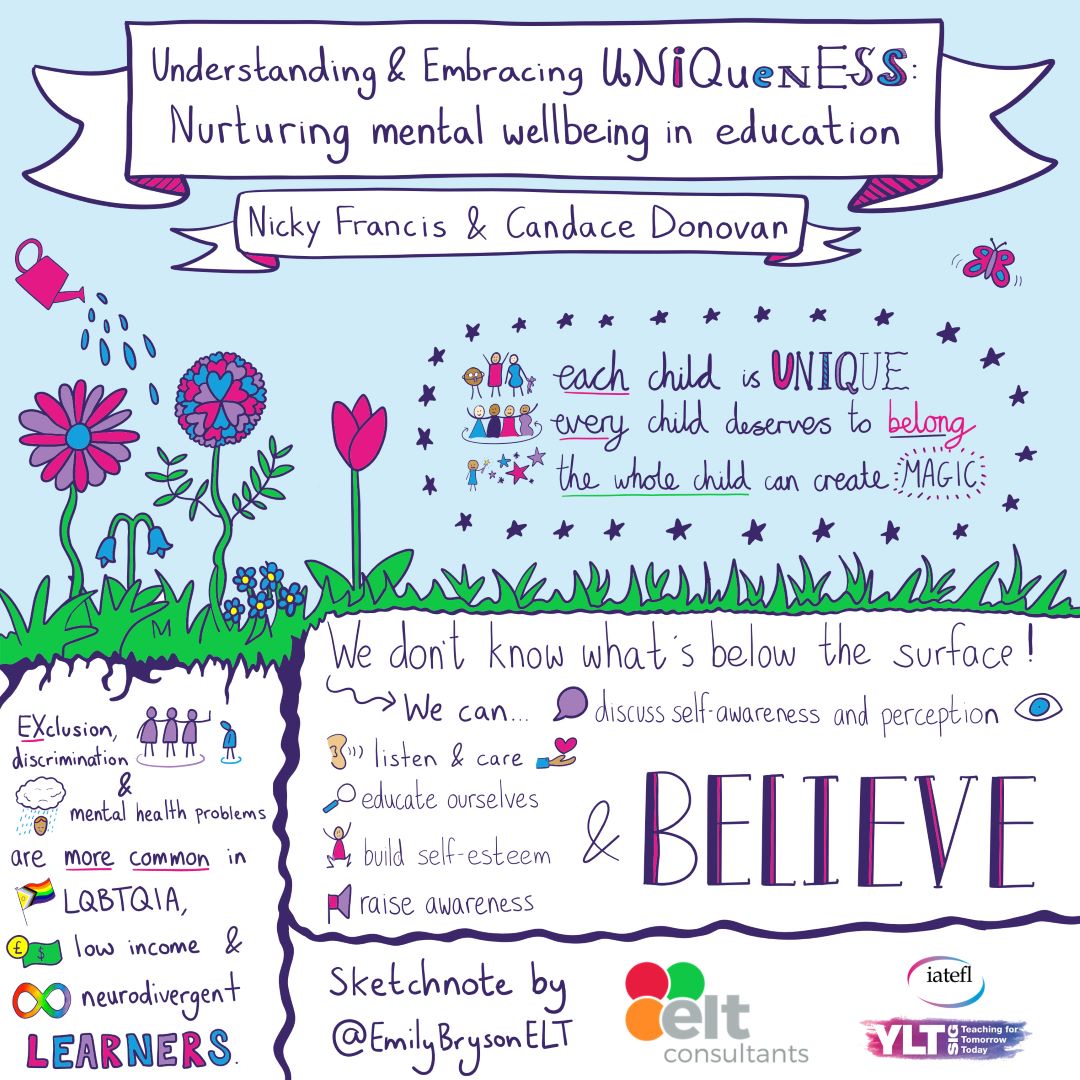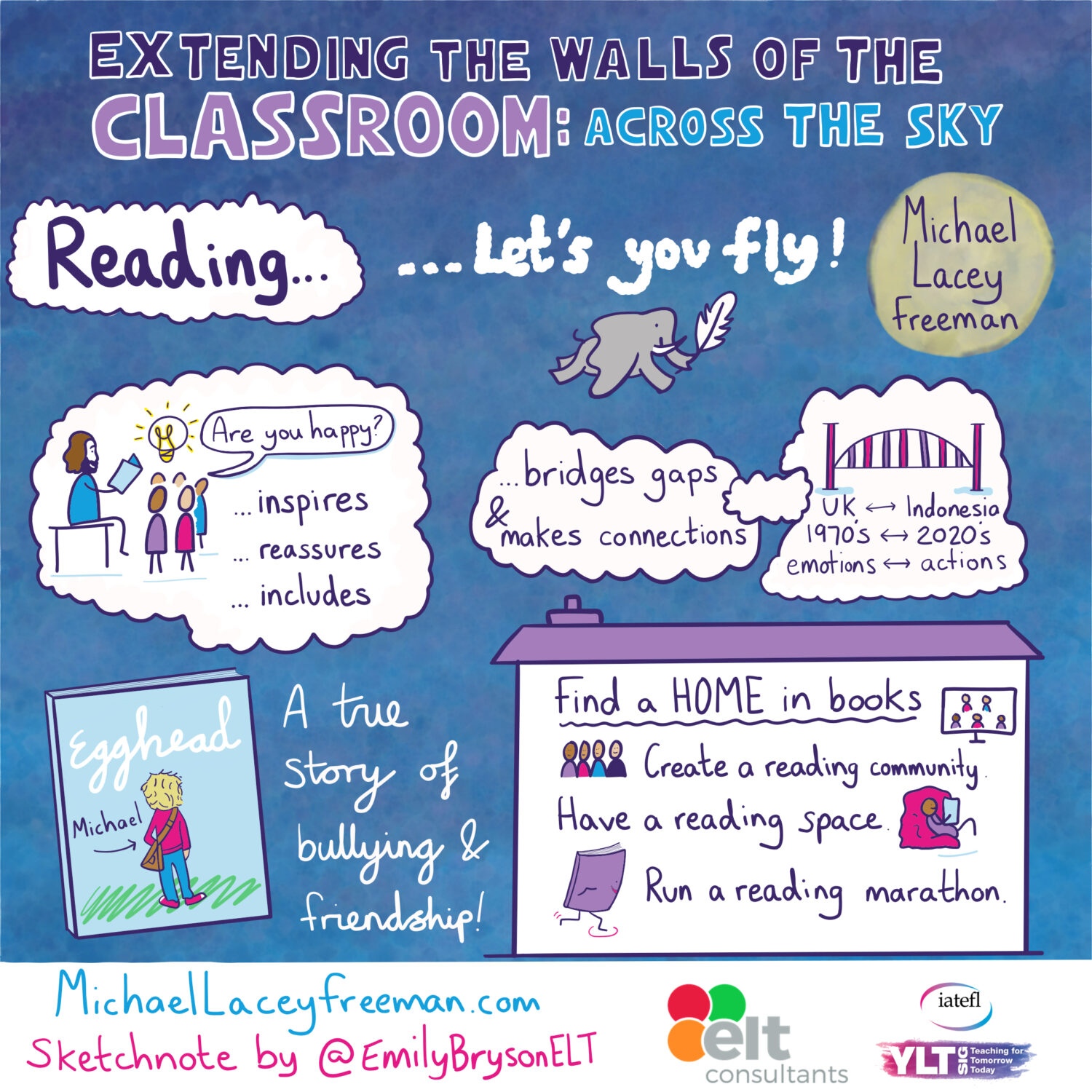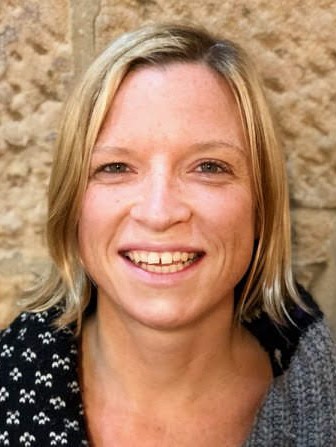I can’t begin to tell you how honoured I am to have been invited to sketchnote the plenary sessions at the YLTSIG webconference! What an incredible three days of enthusiastic ELT professionals sharing their insights and knowledge; I feel so lucky to be part of such a wonderful organisation. The webconference brought so many teachers together, each with the shared goal of enhancing learning experiences for ‘each child, every child and the whole child’.
What is Sketchnoting?
Graphic recording is when someone creates a visual representation or summary of a meeting, workshop, document or other piece of information. If you search online, you may see images of someone taking notes on a large wall of paper. Some graphic recorders can create beautiful visuals of meetings or events. The techniques can also be used more informally on whiteboards in class or in a notebook as a sketchnote.
Sketchnoting is a method of taking notes using text and simple doodles. The drawings do not need to be artistic or perfect, but only to convey a message in a meaningful and memorable way.
Graphic recording and sketchnoting use a simple drawing style, often referred to as a visual vocabulary. Much like learning a new language, learning to draw each individual icon takes time. The more icons you can draw quickly, the easier it is to use them to aid communication.
What are the benefits of Sketchnoting?
There are many benefits, especially in the English language classroom. It’s a multisensory approach which can boost creativity, critical thinking and collaboration. It can also enhance concentration, understanding and information processing. Overall, it is a great way to make note-taking fun and memorable. If you flick through a notebook full of handwritten text, then stumble across a page with a doodle or colourful visual, it’s obvious which page you’re most likely to remember. And if your notebooks are full of fun doodles, you’re much more likely to want to revise or share them, too!
On a personal level, it has changed my life. For many years, I struggled to pay attention during a class or webinar. Now, when I take visual notes, my mind is completely focused on the session. What is more exciting is that I actually look at my notes again and remember their content.
Why was I asked to sketchnote the plenary sessions?
We wanted to create fun, colourful visual summaries of these important sessions. Each sketchnote contains key takeaways which other educators can learn from and share onwards.
Sketchnotes also serve as a lasting reminder. While a talk might only last an hour, a visual recording can stand the test of time. I’ve now created sketchnotes for a number of conferences, and what I’m realising is that not only do they serve as an eternal snapshot, but more importantly they are the gift that keeps on giving. After this conference I was described as the ‘sketchnote fairy’ with my ‘magic pen’!
The key takeaways
I’ll now take you through some of my design choices for each sketchnote, which will hopefully show you how it works and inspire you to give it a go yourself. As an engaging teaching approach, teachers can share sketchnotes with their peers, create tailored notes for classes, or use the skills to add a touch of magic to whiteboards. Moreover, you can encourage and support learners to try it for themselves.
Dario Luis Banegas – Making English Language Learning Socially Just
I absolutely loved this session by Dario. He talked about student generated materials and posed the question: ‘Are the topics published resources ignore the most important ones?’
My personal answer here would probably be similar to that of Dario’s learners: YES! It was heartwarming to see that, when asked to create their own resources, students immediately went for topics with global importance – such as equality, discrimination and human rights.

In this sketchnote, there are lots of examples of what graphic recorders refer to as ‘containers’. A container is an icon drawn big enough to ‘contain’ information. Here, I’ve used them to section off ‘topics’, ‘materials’ and ‘activities. For the ‘topics’ section, I’ve used a clipboard, to suggest the process students went through compiling the list of topics they wanted to focus on. The ‘materials’ container is a large sheet of flipchart paper, as if displayed on a wall with two drawing pins and the bottom corner turned up. For the ‘activities’ section, I chose to use a playing card, to link the idea of games and activities.
I used a speech bubble and a thought bubble to contain a quote from a student and Dario’s poignant thought. The title is encapsulated in a hand, which is an icon often used to signify support, trust or justice. I thought this was apt given the session title!
If you’d like to know more about the Spencer Project, and how learners created their own resources, check out the full webinar here.
Maria Davou – Unlocking Potential: exploring play-based learning for young learners
I had lots of fun creating this sketchnote. I wanted it to be playful, like Maria’s presentation and teaching style. During her session, Maria shared LOADS of examples of ways she’s used structured and unstructured play in her classroom. In fact, Maria shared so many fabulous ideas, that the first version of this sketchnote ended up a bit of a mess. Sometimes that happens, and the beauty of digital note-taking (or erasable pens) is that you can start again!
My main conundrum with visualising this session was how to convey structured and unstructured play. I had a think about all the icons in my visual vocabulary that I often use for topics like games, playing and activities. Then it came to me – of course: the jigsaw!

The structured sections are all completed parts of the jigsaw. The white squares on the left show the flow of Maria’s lesson. I made the lettering of ‘unstructured’ in these white squares float about to express less structure. The pink jigsaw pieces in the middle share information on structured play, so I connected these. Meanwhile, the light purple jigsaw pieces at the top are separated because these contain advice on ‘unstructured’ play. The blue pieces on the right contain some of the benefits of play for learners.
For the heading, I decided to use a key, as the title of Maria’s session was about ‘Unlocking Potential’. I thought I’d add a playful little problem to solve too. Can you spot it?
As with all my sketchnotes, this is simply a summary of some of the key takeaways from the session. For all the fabulous ideas and tips, you can watch the full session here.
Andre Hedlund – The Power of Self-Regulation: a lesson from Captain Marvel.
I had the idea for how to layout this session as soon as I saw the title. As a lover of graphic novels, I was really excited to hear what Andre had to say. As usual, he didn’t disappoint. It was a MARVELlous session.
I unsurprisingly used a variety of different comic strip panels and text styles. I also laid out the key takeaways in the form of a short, visual story. The heading starts in a thought cloud, then the text ‘Captain Marvel’ is highlighted by giving it a separate panel, shaped like a classroom whiteboard. The teacher here is wearing a cape, to portray our underlying superpowers, and to express the ‘lesson’ that Captain Marvel can teach educators.

In the opening panel I traced Captain Marvel. She pops out of this panel, as she might in a comic strip. The exclamation mark is also oversized and I’ve used a different text style to highlight ‘super powerful’.
I used a jagged callout on the right, to express a problem: young learners haven’t learned to control their powers. This is further illustrated by an angry devil, stamping their foot. I used YLTSIG pink here, as it was the closest to red, a colour often used to show anger. In his talk, Andre talked about how when students misbehave it’s simply because they haven’t yet learned to self-regulate their emotions.
The next box states that, as teachers, we can help students to ‘identify, feel and deal with their emotions’. In this panel, I used a variety of emojis to express ‘identify’, a hand to signify ‘feel’ and a thought cloud with a process arrow to convey ‘deal with’ emotions. The final icon is a heart, to show that students can learn to act in a kind way.
The final panel shows a teacher, using their superpowers to gently push students in the right direction.
If you’d like to learn more about how to harness your superpowers and help your students self-regulate their emotions, check out Andre’s full session here.
Anju Moses and Dinesha Senaratne – Empowering Education: Nurturing Hope & Equity in Underserved Communities
As an ELT professional who has spent a great deal of my classroom practice with underserved communities, this session was close to my heart. Anju and Dee really shared the importance of taking care of students’ basic needs in order for education to be successful.
I wanted to share the presenters’ key advice. I used a variety of icons to represent each. The first is the hand that I also used in Dario’s title to express social justice. Here, I’ve used it to represent equity, support and learner needs. I used capital letters for NEEDS and put them on the palm of the hand to show how teachers can help meet them.

For the other icons, I used a white background, with YLTSIG navy script. Throughout these sketchnotes I’ve used YLTSIG brand colours but most of the text has a white background. This makes it more accessible as the colours contrast more and are therefore easier to read.
The final icon on the bottom right is larger than the others, as I felt Anju and Dee kept emphasising the importance of kindness. Supporting learners with their basic needs can help them succeed, but doing so with genuine care is essential.
For more detailed information, and to see for yourself just how lovely and kind Anju and Dee are, check out the full session here.
Nicky Francis and Candance Donovan – Understanding and Embracing Uniqueness: Nurturing Mental Wellbeing in Education
One of the many things I loved about the YLTSIG webconference was the focus on diversity, equity and inclusion. The theme of ‘each child, every child and the whole child’ really leant itself well to sessions focused on embracing the uniqueness of every learner. In this session, Nicky and Candace brought the importance of nurturing mental wellbeing to life. Their relaxed, conversational presentation style had me transfixed.
I was inspired by the presenters’ use of ‘nurturing’ in terms of supporting our learners to grow. I also wanted to convey ‘uniqueness’ so used a different style for each letter in the word, and I used a range of different flowers to show the diversity of our classrooms. To create different sections for each takeaway, I created a root system. These also allowed me to position the quote ‘We don’t know what’s below the surface’ under the grass in the garden of unique flowers.

My choice of flowers was partly based on what I thought would look good in YLTSIG colours, but I also added a couple of additional metaphors here. Firstly, I used forget-me-nots as Candace and Nicky raised the importance of noticing and caring for every learner, and not to let any be forgotten!
The second is the marigold. This is the large flower in the middle. Although Candace and Nicky didn’t mention marigolds, they did talk about how to support our learners. On social media some time ago, Bhavna Gupta taught me that if you plant a marigold next to any plant, it will help it thrive. This turned into some lovely online activity with ELT peers tagging the fellow marigolds in their life. Many of you reading this may remember so it seemed fitting to create a marigold in IATEFL colours. Feel free to tag yours if you share this post or sketchnote any time!
I’ve only captured a tiny shoot sprouting in the garden. I highly recommend you watch the whole session here.
Michael Lacey Freeman – Extending the Walls of the Classroom: Across the Sky
This was another session I couldn’t wait to sketchnote as soon as I saw the title! It instantly had me thinking of a starry sky or different galaxies. You’ll notice that most of the text is contained in fluffy clouds, and that Michael’s name is framed by the moon.
Michael’s session was truly inspiring. He shared his experiences of reading his books to children around the world. In the largest cloud, I’ve drawn Michael surrounded by enthusiastic kids after one of his talks. This is what Michael refers to as a ‘circle’, which naturally forms when students are engaged and keen to know more.

The question ‘Are you happy?’ is one that Michael gets asked often after reading his book ‘Egghead’. The book is a true story about being bullied and making friends. It resonated with me as it does with many children around the world who have similar experiences and memories.
One of his reflections was how reading can bridge gaps and make connections between different countries, decades, emotions, and behaviours. I drew a bridge here, and joined the clouds to demonstrate these links. In the bottom right-hand corner, I added some of Michael’s tips for encouraging students to read. I’ve used a house as a container here as I was inspired by his quote ‘Find a home in books’.
As for the flying elephant, I’ll leave this as a teaser to entice you to watch the full session. You can do that here.
I hope you enjoyed reading the inside perspective of how I created these sketchnotes, and feel more confident to try it yourself!

